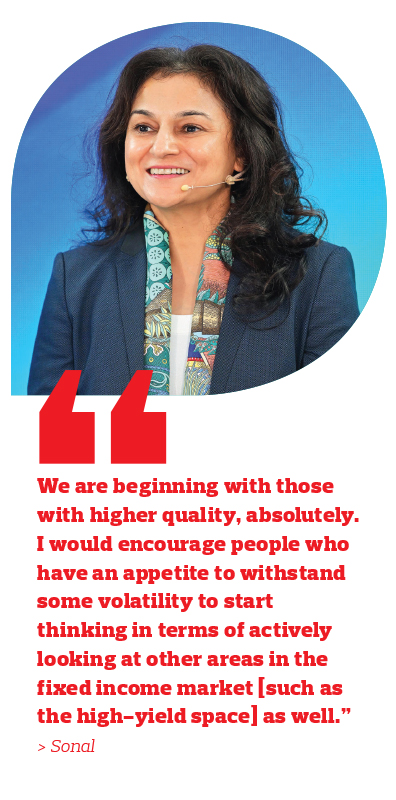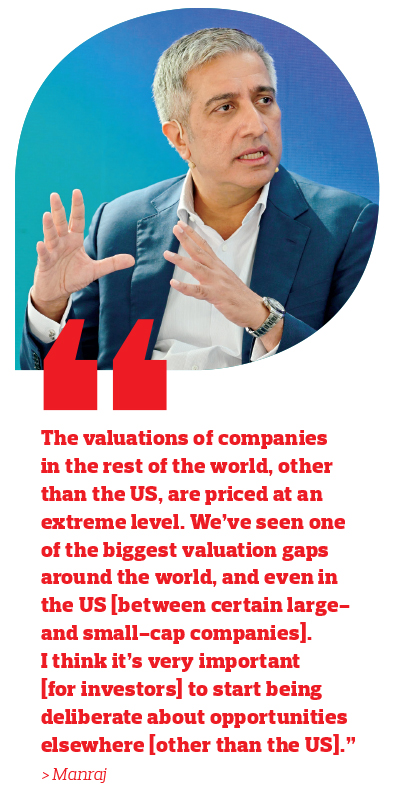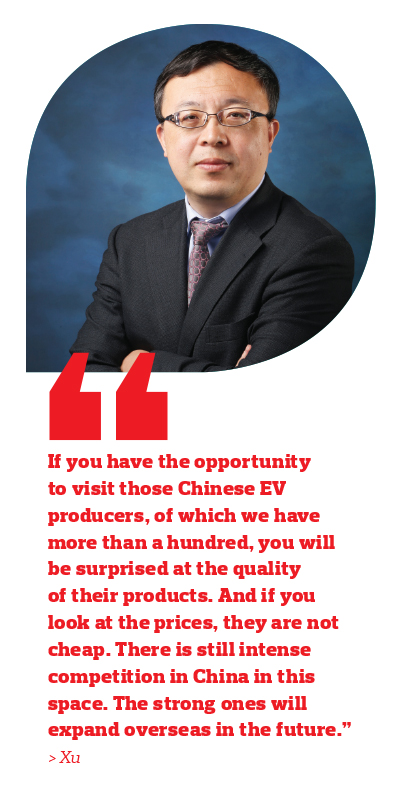
Xu Lirong (centre), general manager and chief investment officer at Franklin Templeton Sealand Fund Management Co Ltd, shared his views on the China equity market (Pictures by Franklin Templeton)
This article first appeared in Wealth, The Edge Malaysia Weekly on November 27, 2023 - December 3, 2023
Franklin Templeton (FT), one of the world’s largest asset managers with more than US$1.5 trillion in assets under management, sees opportunities in long-term bonds. Investors with a higher risk appetite may want to look at better quality high-yield bonds, which can see yields as high as 9% per annum.
It is worth noting that long-term bond yields in the US, represented by the 10-year US Treasury Note, had fallen to 4.58% on Nov 8 from 4.99% on Oct 31 after the Federal Reserve announced its decision to keep interest rates steady at 5.25% to 5.5%. At 4.99%, the yield on the 10-year US Treasury Note was at its highest since Sept 28, 2007, on a quarterly basis, according to Bloomberg.
As for equities, FT favours undervalued small-cap companies around the world. US technology stocks are also looking attractive, given their valuations and potential growth.
Fixed income in China is currently unattractive to the firm. As for whether Chinese equities are worth going into right now is debatable with the fund managers having slightly different views.
Dr Sonal Desai, executive vice-president and chief investment officer at FT Fixed Income, expects US interest rates to stay higher for longer, but does not foresee a recession happening next year. A slower economic growth is more likely to happen in the US.
At a panel session at the FT Asia Pacific Investor Forum 2023 — Media Day event, held on Nov 2 in Hong Kong, Sonal said US interest rates could stay higher for longer, as bringing the inflation rate down to 2% from 4% is much harder to achieve than from 9% to its current level.
“When we see rates at 5% to 5.25%, we think it’s a reasonable level for where rates should be, given where inflation is. Inflation is absolutely coming down … but the last 200 basis points (bps) of bringing the inflation rate down are likely to be the hardest. Indeed, we haven’t seen the continuation of a declining rate [in the past few months],” she added.
From a yield curve perspective, Sonal said the spread between the US short- and long-term yields have historically been around 130bps to 180bps without a massive recession, which is higher than the current level.
“[There is still room for long-term yields to go up] if you look at the short-term yields at around 5%. I’m not expecting 6% plus long-end yields, but there’s a lot of support for an upwards slope in the yield curve. There’s nothing driving that long end down right now,” she added.
Furthermore, the relaxation of the Bank of Japan’s (BoJ) yield curve control (YCC), implemented since 2016, will have implications on US Treasury yields and the bond market, Sonal cautioned.
Under the YCC, the BoJ targets short-term interest rates at -0.1% and the 10-year government bond yield at around 0%. An allowance band of 0.5% was set above and below the targets.
According to news reports, the 10-year Japanese government bond (JPB) yield rose 6bps to its highest level in a decade at about 0.95% after the BoJ’s review of the YCC on Oct 31. But it had fallen to 0.86% as at Nov 8.
The relaxing of the YCC means Japanese bond yields will rise moving forward. Japanese investors are expected to scoop up more local bonds and buy less US debt.
On the other hand, the US government’s budget deficit is likely to stay elevated at more than US$2 trillion in the next few years. US long-term rates will need to rise to attract more investors from around the world.
“On the supply side, you have issuance problems coming from the deficit. Then, I look at the demand side. The largest [foreign] holder of US Treasuries will no longer be buying [as much],” said Sonal.
As inflation is expected to be stickier and deflation not on the cards, investors will be less likely to rush into US Treasuries in a big way, she added.
One of Sonal’s highest investment convictions is to start looking at long-term bonds. “We have been short duration for a very long time. But the time has come to start extending [the duration] in fixed income,” she said.
Sonal noted that investors were anticipating that fixed income instruments would not deliver equity-like returns. But the income they generate is decent.
She said investors with a higher risk appetite can start looking at the high-yield space, which can provide yields as high as 9%. “We are beginning with those with higher quality, absolutely. I would encourage people who have an appetite to withstand some volatility to start thinking in terms of actively looking at other areas in the fixed income market [such as the high-yield space] as well.”
Sonal pointed out that some emerging market debt, especially in Asia, are looking attractive as well, as they are in a very good position from a long-term perspective.
“We see a lot of value in emerging markets, broadly speaking. You just have to pick your position and recognise that it will not be smooth sailing. It will be volatile. From a valuation and bottom-up perspective, there is enormous value in emerging-market [debt],” she said, singling out South Korea and India as the two bright spots.
While markets have concerns about the impact of higher US interest rates on emerging markets, the impact varies from country to country, said Sonal.
“Keep in mind that Asian cycles, to some extent, pre-date the US cycle, in some ways. In the sense that many Asian economies raised rates much earlier than the US, and they are in a better place now from a growth and inflation perspective,” she adds.
Another investment theme that fixed income investors can ride on is the friend-shoring trend, where companies are moving their supply chain away from China to other countries. The beneficiaries include Malaysia, Indonesia, Vietnam and India.
As for China, its fixed income market doesn’t look attractive yet as its property market looks grim, said Sonal. The local government financial vehicles had also soaked up a lot of debt.
“An area that has not gained enough attention is the local government financial vehicles. There’s a lot of debt building up. I think that’s definitely something I’m monitoring very closely,” she said.
Sonal elaborated that the two-year Chinese government local currency debt has a yield of about 2.3%, which makes it less attractive than, say, US Treasuries. Also, the renminbi is not expected to strengthen significantly in the near future.
“So, from a straightforward portfolio allocation perspective, China doesn’t offer the most value right now,” she said.
Magnificent seven or global small-cap stocks?
Moving on to equities, two FT investment specialists shared their views on whether investors should place their bets on US tech giants, which had seen their share prices rally this year, or on undervalued companies globally.
Manraj Sekhon, chief investment officer at Templeton Global Investments, takes the view that investors should start widening their nets beyond the US to bargain-hunt around the globe for better returns.
During the session titled “Future of equities investing: A closer look at developed and emerging markets”, he said the shares of many quality companies around the world were trading at a huge discount to their historical prices, especially small-cap ones.
As the Fed’s high interest rate cycle is expected to come to an end, economic growth could spread wider around the globe, providing investors with good opportunities to identify future winners.
“The valuations of companies in the rest of the world, other than the US, are priced at an extreme level. We’ve seen one of the biggest valuation gaps around the world, and even in the US [between certain large- and small-cap companies]. I think it’s very important [for investors] to start being deliberate about opportunities elsewhere [other than the US],” said Manraj.
He sees growth in the emerging markets, with fundamentally solid and undervalued companies found in Brazil, India and Southeast Asia.
In Southeast Asia, Manraj favours commodity players in Indonesia that are riding the electric vehicle (EV) and green energy wave. Its fiscal condition, including its capital and current accounts, also looks good.
“When you think about commodities, whether it is in Indonesia or Brazil, those companies price [their products] in real terms, not in nominal terms. As you see inflation becoming stickier, these companies with the ability to pass on price increases quite effectively will benefit from the tailwind,” he said.
Pockets of investment opportunities can be found in Thailand and the Philippines, but in traditional sectors such as consumer and financial services, said Manraj.
“We got all sorts of questions on Vietnam. It is a very interesting economy. But from a public market point of view, it’s relatively narrow, which makes it difficult for us to get exposed to that. But Vietnam is certainly a beneficiary of supply chains being repositioned around the world,” he added.
Manraj expects economic growth to slow down in the US, instead of a sharp recession, as the consumer and financial sectors, as well as corporate balance sheets, are in relatively good shape.
“The areas we think a slowdown is likely to manifest more sharply is probably the real estate sector, which will have ripple effects across the economy. I think it is not a bad thing, as the health of the corporate sector is pretty strong right now,” he opined.
However, Manraj observes that most funds flowing out of China went into specific countries or regions, such as India, the Middle East and Latin America, as opposed to emerging markets ex-China as a whole. “In terms of [Asia] ex-China, a lot of discussions, but very little in terms of activities,” he said.
All these do not mean that investors shouldn’t look at technology stocks listed in the US, including the “Magnificent Seven” — Apple, Microsoft, Nvidia, Meta, Alphabet, Tesla and Amazon — which largely contributed to the rise in the S&P 500 this year.
Jonathan Curtis, incoming chief investment officer at Franklin Equity Group, said the share prices of the US tech giants have rallied but they are still not overvalued. For instance, Microsoft shares were being traded at a price-earnings ratio of more than 30 times.
Curtis noted that Microsoft is making its generative artificial intelligence (AI) feature available to a billion commercial users of Microsoft Office at only US$30 per month. Assuming that all Microsoft Office commercial users pay for the AI feature, that would generate US$180 billion a year for the company, which is equivalent to its annual revenue in 2020.
Microsoft has four main businesses, and Microsoft Office is just one of them. The company can continue to grow its gaming and cloud computing businesses. “At 30 times earnings, with that growth potential, it doesn’t look expensive to us,” he said.
However, Curtis believes investors could do equally well, or better, over the long term if they can find value in small and mid-sized US tech companies with lower valuations and are riding major tech trends such as AI.
MongoDB, a provider of tools that help companies run big data applications, is one example. The tech investment theme Curtis is looking at includes AI, cloud computing, 5G, the Internet of Things (IoT), cybersecurity, financial technology and digital payments.
Active and long-term approach to China equities
China, the world’s second-largest economy, went from fund managers’ favourite to one of the most unloved markets in recent years. FT’s fund managers who run various investment strategies have slightly different views on its economy and stock markets.
Xu Lirong, general manager and chief investment officer at Franklin Templeton Sealand Fund Management Co Ltd, said bottom-up stock pickers can find good bargains in China’s stock markets when most investors are fearful.
During a post-event interview with Wealth, Xu said it is now a good time for those with an investment horizon of three to five years to enter China as valuations are low. It is a test of one’s patience.
“I think it is very good timing if you have the patience. From a sentiment perspective, you can see it, right? It is so bearish. And the valuations right now are very cheap compared with the historical numbers and the rest of the world.”
Xu said some Chinese companies grew during the pandemic and are continuing to do so. These are what investors should look out for. “From an earnings perspective, corporate earnings are quite strong in many areas, which means they could beat the bearish sentiment moving forward.”
Could some Chinese companies with low valuations end up being value traps? Xu said the answer is clearly no, as the fundamentals of some of these companies remain solid. Their prices are low mainly due to the bearish market sentiment, after the Chinese economy did not rebound as strongly as expected.
Investors should look at growth sectors and companies in China, such as some EV manufacturers which have expanded their businesses out of China, he added.
“If you have the opportunity to visit Chinese EV producers, of which we have more than a hundred, you will be surprised at the quality of their products. And if you look at the prices, they are not cheap. There is still intense competition in China in this space. The strong ones will expand overseas in the future,” said Xu.
“The EV sector is one of many growth sectors. There are others, like the solar industry, and even some of the traditional sectors. We will see more good ones expanding their capacity abroad.”
As many foreign investors have pulled money out of the Chinese stock markets, their holdings are now at about 4% of their total market capitalisation. It used to be 5% to 6%, he said.
“China contributed to about 16% of the world’s GDP. If you look at this, the positions of foreign investors in the China market are very low. From this perspective, the potential inflows in the future, let’s say in the next three to five years, are quite clear,” he added.
Save by subscribing to us for your print and/or digital copy.
P/S: The Edge is also available on Apple's App Store and Android's Google Play.
- SumiSaujana slumps on ACE Market, on course to be worst IPO debut
- Asian stocks tumble again as US hits China with 104% tariffs, Treasuries slammed
- US slaps higher taxes on small parcels in tit-for-tat trade war
- Malaysian palm oil producers could capture US market share from Indonesia with better pricing — CGS International
- US stocks take another roller coaster ride on US-China threats
- Khee San says its facilities are fully operational now that gas supply has been restored
- UK could nationalise Chinese-owned British Steel, Bloomberg reports
- What two oil firm ads show about where UK regulator draws the line on greenwashing
- Nintendo’s Switch 2 sales forecast cut by researcher over Trump tariffs
- Poultry players trade below long-term average as egg subsidy removal looms




